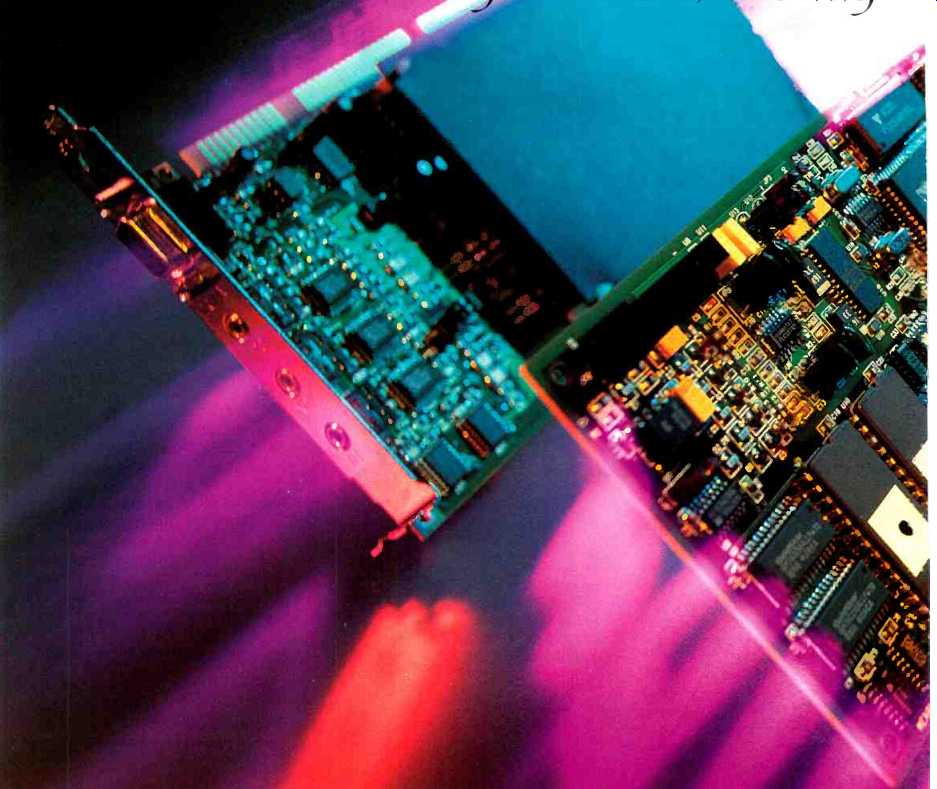
by Bascom H. King
Audio and computer techno have long been converging. Digital audio systems, such as CD, use computer technology wholesale. while many a tuner, tape deck, or preamp incorporates microprocessor control. At the same time, "multimedia" computers incorporate audio facilities for music production (directly, as synthesizers, or via MIDI instrument control) and for reproduction of sounds from games, from CD-ROMs, and even from music CDs. Computers can record digital audio, too, to hard disk or to CD.
It was easy to ignore computer sound boards when all they could do was reproduce the bleeps and bonks of computer games and when games were the only applications using them. Now, however, serious application programs, from business presentation to CD-ROM software, often employ audio. In addition, today’ sound cards claim CD–quality recording and playback. We asked Bascom King to how well two of the best-known PC sound cards deliver on that promise--and asked computer and audio authority John Woram what's involved in turning a PC into a multi media system.
-I.B.
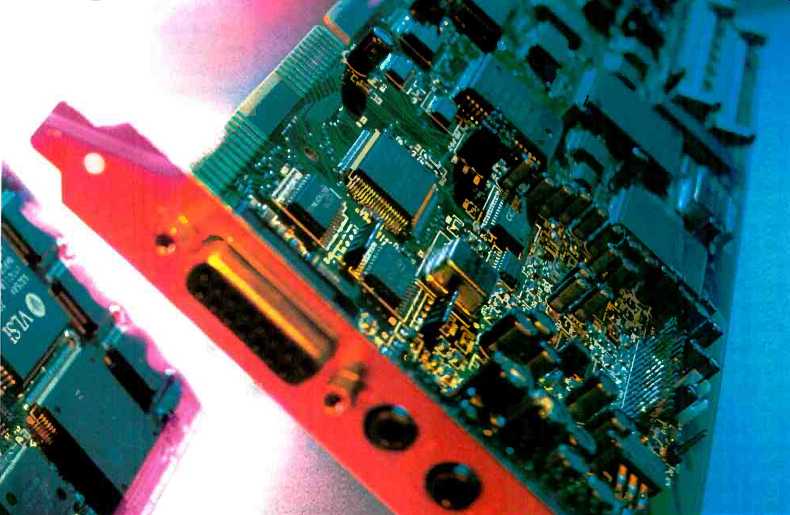
With the right sound board (or card), a computer can make the most of game and multimedia programs and act as the centerpiece of a digital home recording and editing studio--of sorts. Even multimedia computers, which by definition include sound cards, can sometimes benefit from an upgrade to a better card.
My intention in measuring these sound cards was to compare their performance to the standard attainable with CD players in order to see if the claimed "CD quality" label was, in fact, accurate.
The two cards tested here, Creative Labs' Sound Blaster AWE32 ($399.95) and Turtle Beach's Monterey ($399), share a number of useful capabilities. Both can record and play back digital sound, with 8- or 16-bit resolution, from analog sources, CD, CD-ROM, or synthesized signals generated by the board itself. Both can mix and alter audio signals. They can control or be controlled by musical de vices using the Musical Instrument Digital Interface (MIDI) Standard, and they include joy stick ports for use with games and other software.
Both cards require PC-type computers with 80386 (or later) processors, an empty 16-bit slot, and at least 2 megabytes (MB) of RAM. Users who intend to record should also have plenty of hard-disk space available.
Beyond that, the two boards differ considerably. For instance, Creative Labs' Sound Blaster offers both FM synthesis (for backward compatibility with older pro grams and the generation of non-imitative sounds) and the more realistic-sounding wavetable synthesis; the Turtle Beach offers only wavetable synthesis. These boards adhere to the General MIDI specification, which defines patch numbers for 128 musical-instrument sounds and sound effects, and they surpass the required 24-note polyphony. Both can, in fact, handle 32-note polyphony, though the Turtle Beach goes beyond the Standard's minimum of 16 MIDI channels, handling 48 channels.
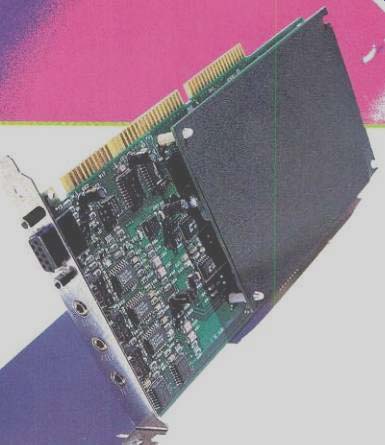
The AWE32 is compatible with virtually all PC games that use sound (for which "Sound Blaster compatibility" is a watchword), but it is not compatible with all Windows multimedia applications.
The Turtle Beach, which is compatible with those applications, lacks Sound Blaster compatibility for games. The Sound Blaster interfaces with the computer through direct memory access (DMA), which can temporarily swamp slower computers if you're processing 16-bit audio. Turtle Beach's Hurricane architecture allows sound data to move through the PC roughly eight times faster.
MIDI FACILITIES
The Sound Blaster AWE32 supports the General MIDI Standard and is compatible with Sound Canvas (GS) and MT-32 sound sets. An onboard ROM holds 1 MB of sound samples. And since the AWE32 uses the E-mu EMU8000 sound and effects chip, it also SoundFont audio library of sampled sounds, which can be downloaded into the AWE32's onboard 512-kilobyte RAM ( expandable to 28 MB) for added sound variety and flexibility.
The MIDI facilities can be expanded, sometimes to near-orchestral levels, by plugging in Sound Blaster-compatible modules from Kurzweil, Roland, or others. These modules add additional sampled sounds and effects.
AUDIO FACILITIES
The Turtle Beach Monterey, which uses the Motorola DSP 56001 chip, holds 4 MB of 16-bit samples in ROM. Its Sample-Store memory also accepts additional wavetable samples but can be expanded only to 4 MB. The Monterey actually combines Turtle Beach's Tahiti sound card and Rio MIDI synthesizer, physically grafted together.
Either board can apply a wide range of effects to sounds. The Monterey's spec sheet lists eight flavors of reverb and six of echo, plus "Fast Delay" and "Lotsa Repeats." Users can also program their own effects. The AWE32's specs list reverb, chorus, pan, and QSound Virtual Audio.
supports E-mu's Turtle Beach stresses audio quality, including detailed (and impressive) audio performance data in its spec sheet; many other sound-card spec sheets (including the SoundBlaster's) omit this in formation. The Monterey's A/D converters are 16-bit sigma-delta types, with 64-times oversampling. The 18-bit D/A converters, also sigma-delta types with 64fs oversampling, use 8f, interpolating filters. The Motorola DSP56001 chip can perform operations like real-time adaptive differential pulse-code modulation (ADPCM) decompression, and provides the needed horsepower for future multimedia standards like data compression.
All analog inputs and outputs of the Monterey are at line level, so you'll need an external amp, as well as speakers, to hear its output. You can, however, hook headphones to its line output.
The AWE32 does have an amplifier, rated at 4 watts peak music power per channel into 4-ohm loads, so it can drive speakers directly. It also has a microphone input and microphone; the Monterey does not.
HARDWARE DIFFERENCES
Both cards require 16-bit slots, but the AWE32 is full-sized, while the Monterey is, at 8 1/2 inches, only about 60% as long; this may be useful in some crowded computers. The Monterey's Rio MIDI circuitry is on a smaller daughterboard.
The AWE32 has digital connections for use with CD-ROM drives, and both cards have analog inputs for CD audio (see John Woram's sidebar "Adding Multimedia to Your PC"). The AWE32 also includes direct support for Sony, Mitsumi, and Creative Labs CD ROM drives, saving the space (and cost) otherwise needed for these drives' proprietary interface cards.
SOFTWARE
Both boards include software for mixing, record-level monitoring, and sound recording and editing. Since the Sound Blaster has a microphone, it has speech-recognition software, too. Less predictably, it also has software to read text as speech. Other Sound Blaster software can embed .WAV waveform sound files in other files that accept OLE (object linking and embedding).
TEST CONDITIONS AND SETUP
With sound cards, as with two-head tape recorders, you can monitor input signals as you record, but you cannot monitor the actual recording as you make it. However, since the recording is on hard disk, the wait to "rewind" the recording for playback and jump from one part of a recording to another is almost imperceptible. It is technically possible, but not trivial, to monitor what is being recorded; while a few other sound cards permit this, neither of the cards reviewed here do.
To measure various parameters as a function of frequency and amplitude, recordings of these various sweeps are made on the computer's hard drive and then played back. To record stereo information at a 44.1-kHz sampling frequency takes a lot of hard-drive space. Each minute of recording takes up about 10.5 MB. A number of test recordings for measurement can fill up a drive real fast, especially when Windows is installed along with a number of soundcard-specific programs. When measuring played-back frequency sweeps, it is relatively easy to set the Audio Precision System One test gear to track the incoming frequency and automatically plot a performance parameter as a function of frequency. But measuring a played-back sweep as a function of recorded amplitude gets quite a bit harder; the instrument loses its ability to track the incoming amplitude at low levels, due to wideband noise from the device under test. One way around this is to record a number of individual signal amplitudes, record the playback data, and have the Audio Precision system make a plot out of it.
I used two PC computers to do this testing, a 486DX-33 and a 486DX2-66. The Monterey was in the DX-33 along with 100- and 240-MB hard drives and 4 MB of RAM; this machine was running Windows for Workgroups 3.11 and DOS 6.0. The AWE32 was in the DX2-66, with a 100-MB drive and 8 MB of RAM, which was running Windows 3.1 and DOS 6.2. (My resident lab computer, an Everex 1800B 286, did its usual duty of running my Audio Precision system.) I found that disk-compression and disk-caching software (such as MS-DOS DoubleSpace and SMARTDrive, respectively) could cause problems keeping up with the thirsty data demands of stereo 44.1-kHz recording and playback, so these programs weren't used. It should be noted that these computers were set up for opt mal measurement of sound cards, with minimum problems. With other computer-system configurations, available resources, etc., there might be some problems in recording and playing back stereo 16-bit material without interruption. In general, you need at least a 486DX-33, 8 MB of RAM, and a fast, large hard drive-despite the lower minimums quoted by the manufacturers.
I have seen two sound-card topologies. In one, the monitor path just goes through the linear audio circuits on the card; the AWE32 follows this pattern. The other, as used in the Monterey, sends the monitored signal through the A/D and D/A conversion processes.
In the first case, one has to record and play back to find out the overall record/play characteristics. In the latter case, it turns out that the behavior in the monitor mode for measurements of frequency response is substantially the same as when actually measuring the record/play characteristics. Of course, you still have to record and play back test files in order to measure all of the cards' characteristics meaningfully.
MEASUREMENTS
Figure 1 shows the overall record/play frequency response of both cards. As can be seen, the Monterey has the flatter frequency response, with the AWE32 having more roll-off at the frequency extremes. The 20-kHz value, some-16 dB, is a bit excessive. Also, the AWE32 has a small but noticeable (about +0.1 dB) upper-midrange rise, presumably due to its tone-control algorithm. I would rate the Monterey, but not the AWE32, in the CD-quality league here. How ever, both these cards have far less low-frequency roll-off than many other sound cards do.
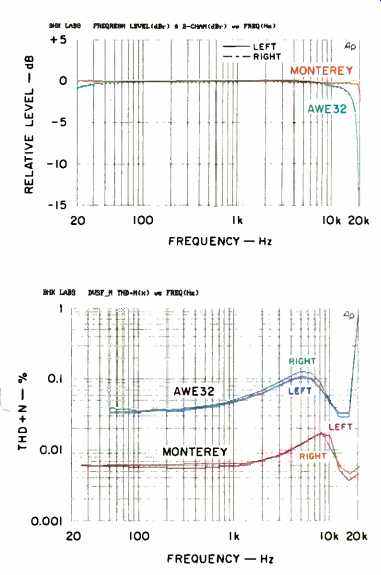
FIG. 1--Record/play frequency response.
FIG. 2--THD + N vs. frequency.
=====================
Adding Multimedia
by John M. Woram
In putting a multimedia system together, there's the easy part (buying the hardware) and the hard part (getting it to work).
If you get a CD-ROM drive and sound card in a bundled package, the bundler has presumably made sure the devices are compatible, thus making the easy part even easier. However, such packages of ten include a pair of so-so loudspeakers and perhaps other stuff you don't really want. So you may very well decide that it's preferable to pick and choose among available components, in order to get just what you need without paying for things you either already have or that you don't want.
With that in mind, here's a quick overview of a few multimedia hard ware options for a Windows-based PC system, followed by a few thoughts on surviving the hard part.
CD-ROM
These days, most multimedia soft ware requires CD-ROM drives. For this reason, many sound cards have built-in controllers for such drives. Some, like the Creative Labs Sound Blaster tested by Bascom King, are designed to work with drives that would otherwise re quire proprietary interface cards (but such drives are rapidly disappearing).
Others have controllers for a single CD ROM drive using the far more common small-computer systems interface (SCSI) connections. If a card is de signed to control a drive you already have or if you just know you'll never want to add another SCSI device (say, a second CD-ROM, another hard drive, or some other peripheral), then such a sound card offers an efficient means to get up and running with minimal fuss.
But the same option becomes redundant if you already have a SCSI controller on board or becomes limiting if you expect to add additional devices in the future. In that event, you can get more bang for your buck by buying a sound card that omits the SCSI connector. Use the controller you already have, or get one that supports more than one device.
Many new computers have Extended IDE (EIDE) or ATAPI hard-disk inter faces; EIDE/ATAPI CD-ROM drives are now becoming available. But most of the computers in the field that don't al ready have multimedia facilities pre date EIDE. And since most of the CD ROM drives now available require a SCSI controller, I'll concentrate on SCSI drives.
If your computer does not already have a SCSI controller, you'll probably need one to support a SCSI CD-ROM drive. But if your system is already set up for SCSI, you certainly don't need another controller just for the sake of this drive. If your system does not al ready have one, add a Future Domain SCSI Controller Kit for support of up to seven SCSI devices. The kit's adaptor card supports both internal and external devices.
In assembling or modifying any multimedia hardware system, don't over look the SCSI terminators that must be enabled on the devices at either end of the physical chain and disabled every where else. For example, if you already have a SCSI controller and hard drive, both devices are presumably terminated. If you attach a CD-ROM drive to a connector on the flat cable between the controller and the hard drive, then its termination must be off. However, if the new drive is placed at either end of the signal chain, then its termination must be on and the termination on the device now in the middle of the chain must be off. If you need to disable termination on a SCSI hard drive, you may have to remove it from the system, turn it over, and search for a tiny juniper on the drive's circuit board.
With luck, you won't have to bother with this if the controller itself becomes an intermediate device in the SCSI chain. For example, the Future Domain controller mentioned above has an auto-termination circuit that senses the controller's location in the chain. If it finds the device is at either end, termination is enabled; otherwise, it's not.
As another consideration, every SCSI device must have a unique ID number (0 to 7). The controller itself is ID 7, while 0 and I are usually reserved for hard disks. If the new CD-ROM drive is the only other SCSI device in the system, set its ID to any number from 2 to 6. Otherwise, just make sure the number does not conflict with some other device already installed. The appropriate ID is usually set by a DIP-switch block on the drive's rear panel. Note that the ID number is simply a logical designator and has no relationship to the device's physical position in the SCSI chain.
As a final interface consideration, note that a CD-ROM may contain audio in any of three formats: Conventional CD audio (16-bit PCM at 44.1 kHz), MIDI sequences and instructions, or waveform (.WAV) files. Conventional CD digital audio is converted to analog at the drive itself; only this signal can be heard at the drive's front-panel headphone jack. An external CD-ROM drive has twin RCA phono jacks on the rear panel, while an internal drive usually has a three- or four-pin Berg connector on its rear panel. In either case a dedicated cable carries analog audio from the CD to the sound card. An external drive's analog output can be easily connected to the line input jack on the card's adaptor bracket or routed to an external amp.
A bit more attention must be paid to the digital interface cable between an internal drive and the sound card, which handles MIDI and .WAV files.
Although a recent MPC (Multimedia PC) Level 2 spec lists pin 1 to 4 assignments as left, ground, ground, and right, the pins on many sound cards don't conform to this standard. For ex ample, the pins on one popular sound card are left, (common) signal ground, right, and chassis ground. As a result, an MPC Level 2 cable connected to this card will feed only one audio channel (left or right, depending on which way the connector is placed over the pins), with the other channel shorted out.
As a compatibility test, I tried to match an MPC-2 CD-ROM drive with a noncompliant sound card. Since the cable supplied with the drive did not match the sound-card connector, I called various multimedia vendors to see what could be done to resolve this problem. Only one (NEC) responded, immediately sending out a complimentary adaptor. The rest either had no suggestions or simply ignored my inquiry. And so, a word to the wise: Be prepared to rewire your own cable, or else make sure this won't be an issue be fore making a purchase.
Once the hardware interface is complete, it's time to tackle the other half of the difficult part, which is the software support. Since CD-ROM drive support is not built into the disk operating system (MS-DOS versions up to 6.22), a software device driver must be loaded into memory as the system starts up. In addition, the data structure on a CD ROM does not match that found on conventional diskettes and hard disks.
Therefore, the Microsoft CD-ROM ex tensions file (MSCDEX.EXE) must also be loaded. To help keep things confusing, the device driver is loaded via the CONFIG.SYS file, while the extensions are loaded in the AUTOEXEC.BAT file.
And as if that's not enough, both lines must contain a common driver signature so that the driver and the extensions can find each other. Accordingly, you should find lines such as these in your own startup files:
in CONFIG.SYS:
device=filename.SYS /d:MSCD000 in AUTOEXEC.BAT:
C: \ DOS \ MSCDEX.EXE /d:MSCD000
In practice, filename.SYS will be the actual name (and path, if necessary) for your own device driver. This example assumes the CD-ROM extensions file is in the C:\DOS directory, although yours might be in the C:\WINDOWS directory or perhaps elsewhere. Finally, note that the common driver signature (/d:MSCD000, in this instance) appears on both lines.
Assuming the CD-ROM drive is physically installed and lines such as those shown above are in your own startup files, basic DOS functions should work once the system is up and running. In other words, you should be able to log onto the drive, view a directory listing, copy files from a CD-ROM to the hard drive, and so on.
Saving the worst for last, the final step is to configure the sound card's interrupt request (IRQ), direct memory addressing (DMA), and input/output (I/O) port address. The sound card uses its assigned IRQ line to let the computer's microprocessor know when it needs attention or else turns to DMA to bypass the CPU and communicate directly with computer memory. The I/O addresses identify the ports by which data flows back and forth. Needless to say, all three parameters must be selected with care so that soundcard operation won't cause a conflict with other devices that also use one or more of these services. Depending on the specific sound card, you may need to specify these settings via jumpers or switches on the card and/or by setting software parameters.
No matter what settings you or the setup procedure select, one thing is fairly certain: Initially, it won't work. Multimedia devices seem to have a talent some might call it a gift-for finding a configuration that will conflict with at least one other device. As a result, you'll be treated to an endless ding-ding-ding loop or some other indignity when you try to access the system. The usual cure is to change an IRQ and/or DMA set ting until you find the combination that works. If you know what settings are taken by other devices, then the work is half done; just choose other values. But if you're not sure about this, then a certain amount of guesswork may be in order. If all else fails, try IRQ 7,10, or 15 and any DMA setting from 4 to 7.
If you think there should be a simpler way, there is: In most cases, Microsoft's new Windows 95 eliminates the need for the AUTOEXEC.BAT and CONFIG.SYS lines cited earlier, as well as doing a pretty good job of finding, and using, multimedia settings that won't cause trouble with any of your other hardware devices.
====================
With either card, when square waves were recorded and played back (not shown), the ringing at their leading and trailing edges were mirror images of each other. This shows that both cards have essentially linear phase characteristics, a desirable quality that's typical of digital audio devices and a function of using finite-impulse response (FIR) filters.
Figure 2 shows both cards' THD + N at full-scale input level as a function of frequency. The measurement filter bandwidth was 22 kHz, in order to get the best picture of in-band distortion values. The high value of distortion near 20 kHz for the AWE32 has two causes. The Sound Blaster is generating real difference tones here. However, the measurement is also a bit inflated because it is expressed as a percentage of the signal level in a region (18 to 20 kHz) where the actual signal level is rolled off, as was shown in Fig. 1. As a point of reference, a good CD player would have distortion values between 0.002% and 0.003%. Many separate D/A converters measure in the range of the Monterey.
The AWE32's somewhat higher THD + N would not be considered CD quality. Figure 3 shows both cards' THD + N for a 1-kHz signal as a function of recorded input-signal amplitude, with a measurement band width of 400 Hz to 22 kHz. This test reveals distortion artifacts at lower levels, such as idle-tone generation.
At levels below fill scale, where the highest distortion occurs, it is frequently just a measure of noise. In the case of the Sound Blaster AWE32, there is some distortion at full scale (an innocuous 0.035%), which quickly disappears in the noise at about 10 dB be low full scale (dBfs). More significant, the general noise level of the AWE32 is about 10 dB greater than the noise level of the Monterey.
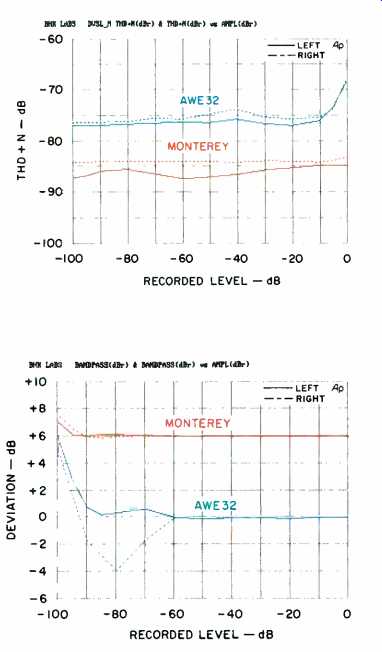
FIG. 3--THD + N vs. recorded level.
FIG. 4--Deviation from linearity (Monterey curve offset by 6 dB for clarity).
Deviation from input/output linearity, or correspondence of output for a given input, is shown in Fig. 4. (The zero reference level for the Monterey has been displaced 6 dB for clarity.) Again, the Monterey is the winner here. I might add, however, that some high-end D/A converters have measured worse than the AWE32 in this test.
The interchannel crosstalk (not shown) for both cards indicated some capacitive coupling, in that the crosstalk increased with frequency at a rate of 6 dB per octave.
The Monterey's crosstalk was more uniform in the two directions; it was better than -90 dB up to about 350 Hz, -70 dB at 4 kHz, and about -58 dB at 20 kHz in the right-to-left direction, and was about 3 dB better yet when going from left to right. In both directions, the AWE32's crosstalk was better than that quoted for the Monterey from 20 kHz down to 1.3 kHz, with left-to-right crosstalk leveling off to about -90 dB in the region from 50 to 100 Hz, while right-to-left crosstalk stayed below -90 dB up to about 1.7 kHz and finished at about -64 dB at 20 kHz. All in all, pretty good crosstalk performance for a piece of audio gear in general, but not as good as the better CD players and external D/A converters can do.
Signal-to-noise ratios at various measurement bandwidths are enumerated in Table I for both sound cards. For these measurements, the line-level inputs that I was using for recording were terminated in 25 ohms and turned fully up, while other inputs were turned down. Noise levels for the AWE32, previously commented on, are some 15 dB higher than good CD player performance. The Monterey is closer to CD performance.
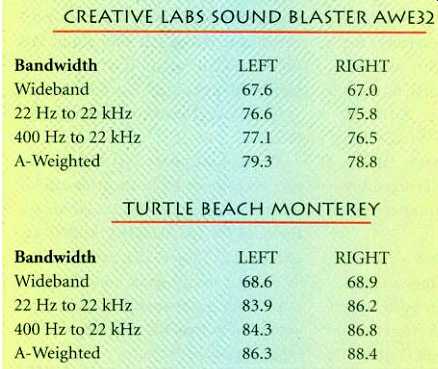
TABLE I--Record/playback S/N ratios, in dB.
Input impedances for the line-level inputs were about 115 kilohms for the AWE32 and about 62 kilohms for the Monterey.
Output impedance at the line outputs was about 70 ohms for either card. The Monterey could easily drive a load of 600 ohms or even lower impedance, such as 40- or 50-ohm headphones, with relative ease. It would put out about 600 mV at about 0.01% distortion into the Joseph Grado Signature HP-2 headphones I used for some of the listening tests. By contrast, the line output of the AWE32 could put out about 73 mV into the HP-2 'phones (and some 800 mV at the onset of clipping into a 600-ohm load, which should be totally adequate for line out use). Of course, higher power demands for headphones and speakers can be satisfied by the on board power amplifier. Neither card's measured performance was affected by the IHF load of 10 kilohms in parallel with 1,000 pF, which means that they should drive any practical load.
The AWE32 inverted signal polarity, both in its monitor output mode and when playing back a recording. The Monterey maintained input-signal polarity in both modes.
I noticed something else when checking the AWE32 card for signal polarity. In order to avoid overloading the AWE32's line input circuitry, I put a 50-kilohm stereo volume-control box between this input and the output of the external D/A converter that was converting my test generator's digital signals to analog. When I happened to switch my test generator from the polarity-test waveform to a 1-kHz sine wave, I noticed that the distortion from the AWE32 was about 0.15% at full-scale input in monitor mode, even though it had been only about 0.033% when fed directly from the Audio Precision's analog output. It turns out that the AWE32's line input circuitry is sensitive to source impedance, and the output impedance of the external volume control (10 to 20 kilohms, at the volume settings I used) caused this distortion increase.
The meter facilities for setting record levels were accurate enough, and were set for 0 dB in the case of the Monterey's VU meters and full deflection in the bar-graph display in the AWE32. Both systems appeared to respond to the program's peak, rather than average, level.
USE AND LISTENING TESTS
To test the sonic attributes of these sound cards, I brought a Parasound C/DP-1000 CD player/transport into the lab, recorded a number of pieces of music on both sound cards, and then played them back through a pair of Grado HP-2 headphones. I compared the sound of the source in monitor mode with the playback. Generally, I was impressed. Both cards sounded pretty damn good. How ever, I could easily hear small pops and clicks with both cards at the start and finish of a recording. The 2-V full-scale output of the CD player would overload the circuitry of the AWE32's line input, which really surprised and annoyed me. No amount of juggling the input gain or input level with the AWE32's mixer software fixed this problem; I had to reduce the actual input level to the card (which I did with my volume-control box). Without testing, I presumed that the CD input, internally accessed via a connector on the card, has appropriate input signal acceptance. By contrast, the Monterey's mixer application has a neat input-level sensitivity adjustment, and the card easily accepted the 2-V full-scale signal.
I then took both computers into my listening room and set them up to work with my main sound system. Here, the Parasound CD player fed a First Sound II passive signal selector and volume control that, in turn, fed the inputs of a pair of Cary Audio CAD-805 single-ended triode amplifiers. The CAD-805 amps drove my resident B & W 801 Matrix Series 3 speakers.
This let me compare the sound of the source coming directly from the CD player with the playback from the sound cards, by switching the First Sound's input cable between sources. I felt the Monterey softened the sound a little and set the soundstage a bit farther back, but otherwise, it sounded quite good.
The AWE32 had a tendency to be a little edgy and to reduce the sense of dimension and space in recordings with good ambience. Otherwise, it sounded pretty good too. Overall, I preferred the reproduction from the Monterey.
At a reasonable playback level, I listened to the noise out of the speakers with both cards, though I could hear a little hiss from the AWE32 that wasn't audible with the Monterey. True, this was with my head in the speakers--but at high playback levels with speakers real close, as in typical multimedia setups, the noise from the AWE32 could be audible. Nevertheless, I think either card would satisfy most sophisticated multimedia users.
The application software that I used consisted of the sound mixers supplied with each card, which I used for level setting, muting inputs, etc. Although the AWE32 comes with an excellent Windows record and playback application (the Monterey doesn't have Windows record/playback software), I used WinDAT from Voyetra Technologies for recording and playback with both sound cards.
Despite their differences, I liked both boards. I plan to buy the two of them for use with my computer programs, for experiment, and for just plain fun.
COMPANY ADDRESSES
CREATIVE LABS, 1901 McCary Blvd., Milpitas, Cal. 95035
TURTLE BEACH SYSTEMS, 52 Grumbacher Rd., York, Pa. 17402
(adapted from Audio, Nov. 1995)
Also see:
Computing audio's future (Jan. 1994)
= = = =